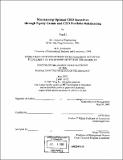Maintaining optimal CEO incentives through equity grants and CEO portfolio rebalancing
Author(s)
Li, Ying, 1971 Mar. 16-
DownloadFull printable version (5.103Mb)
Alternative title
Maintaining optimal chief executive officer incentives through equity grants and chief executive officer portfolio rebalancing
Other Contributors
Sloan School of Management.
Advisor
S.P. Kothari.
Terms of use
Metadata
Show full item recordAbstract
My thesis examines the joint hypotheses that firms set optimal levels for CEO incentives, and that firms and CEOs jointly correct deviations from these optimal levels through equity grants and CEO portfolio rebalancing. I investigate two equity-based CEO incentives, pay-for-performance sensitivity and risk-taking incentive. Pay-for-performance sensitivity is defined as the change in CEO wealth for a given change in the firm's stock price, while risk-taking incentive the sensitivity of CEO wealth to equity risk. Chapter One examines the relation between incentive deviations and subsequent incentive adjustments based on Black-Scholes model (1973). I use this model to estimate both the incentives from CEOs' equity holdings and adjustments to these incentives. I find that firms' and CEOs' combined annual adjustment to pay-for-performance sensitivity or risk-taking incentive is negatively related to the degree that each incentive deviates from its target level at the beginning of the year, consistent with firms and CEOs jointly correcting the incentive deviations. Overall, the findings suggest that firms and CEOs coordinate their equity-granting and portfolio-rebalancing decisions to manage optimal CEO incentive levels consistent with economic theory. Chapter Two examines the relation between incentive deviations and subsequent incentive adjustments based on a certainty-equivalent approach. I only use this alternative approach to re-estimate incentive deviations, and still use Black-Scholes model to calculate incentive adjustments. The results support my findings in Chapter One.
Description
Thesis (Ph.D.)--Massachusetts Institute of Technology, Sloan School of Management, 2002. Includes bibliographical references.
Date issued
2002Department
Sloan School of ManagementPublisher
Massachusetts Institute of Technology
Keywords
Sloan School of Management.